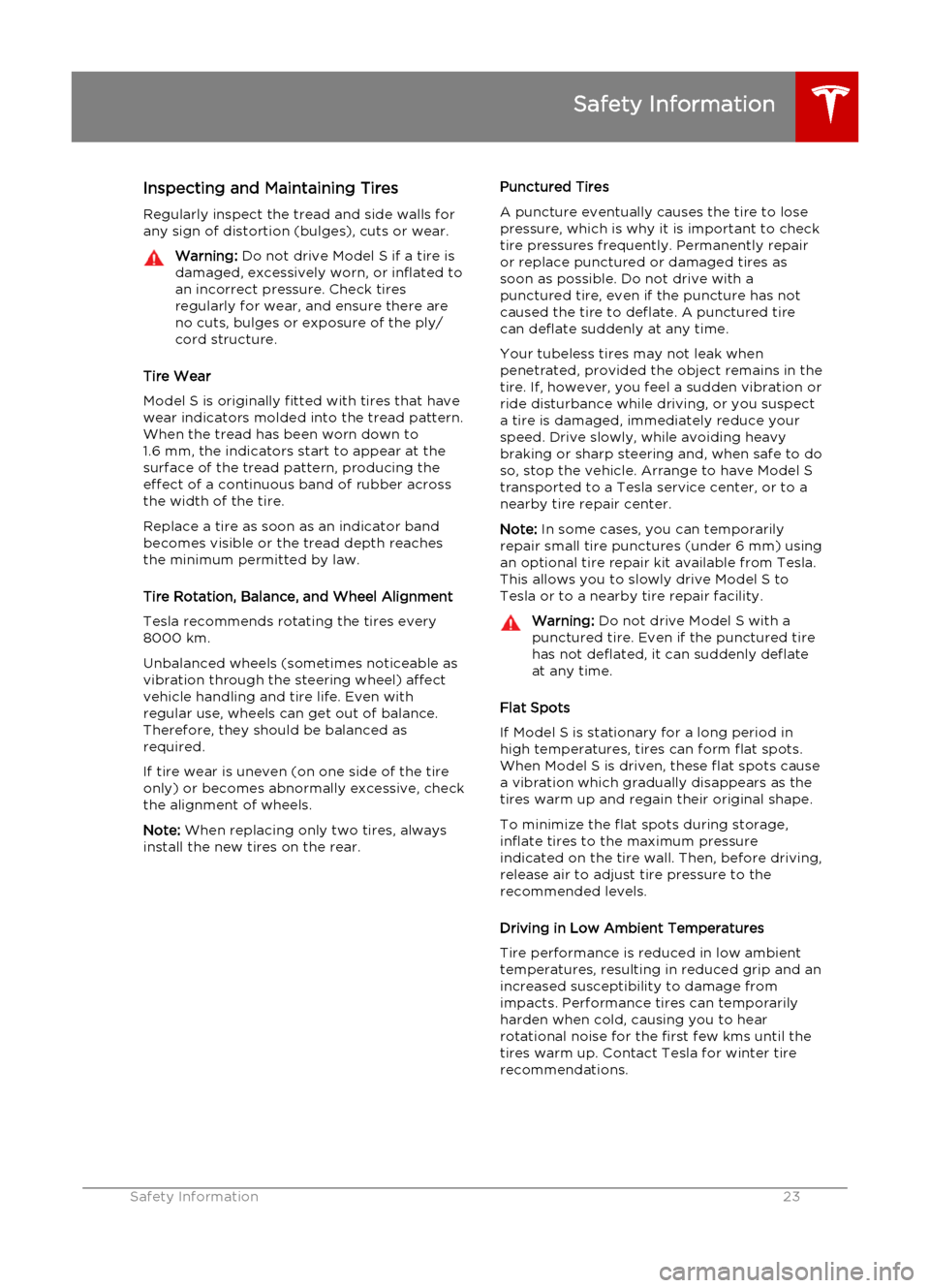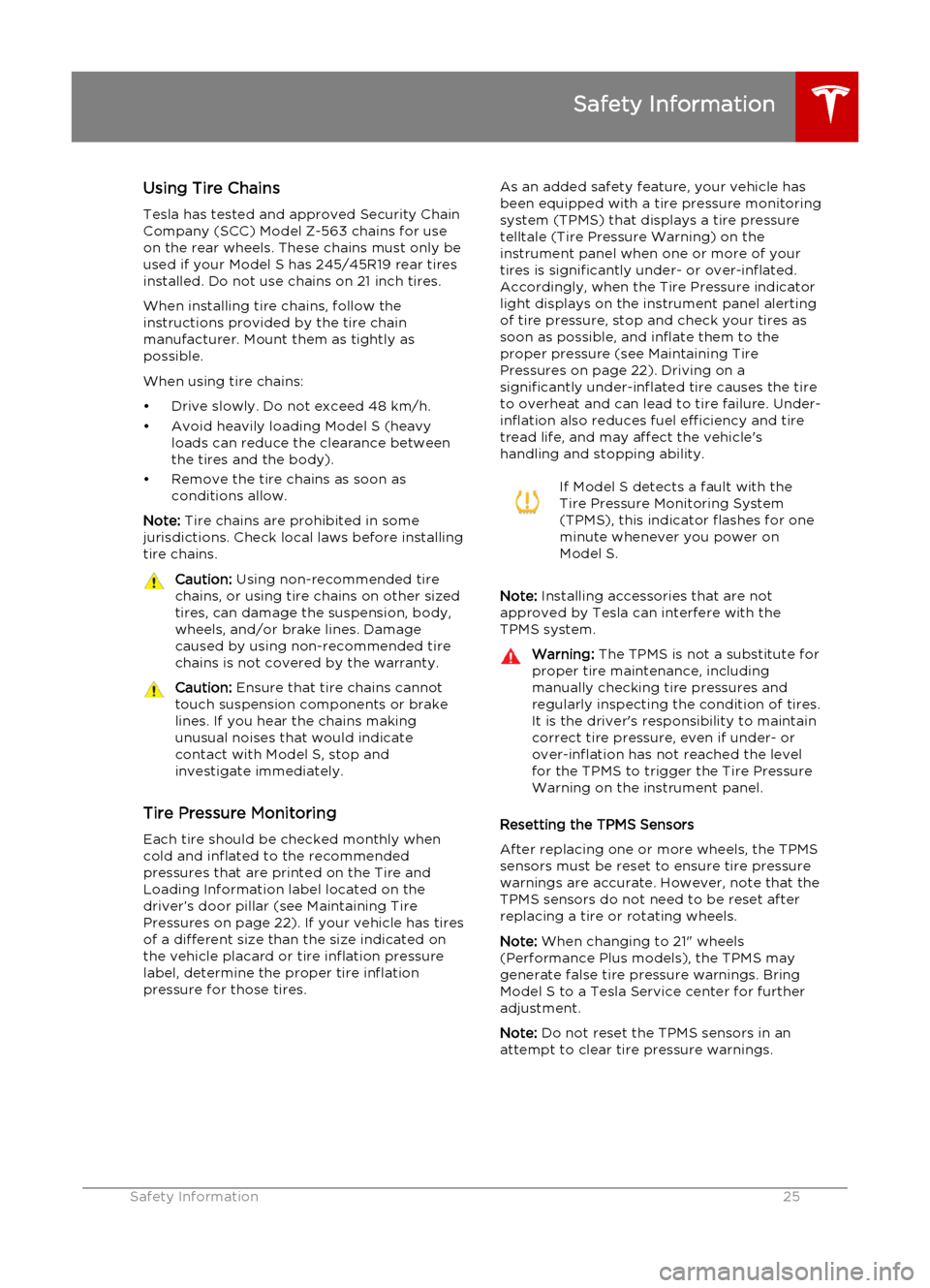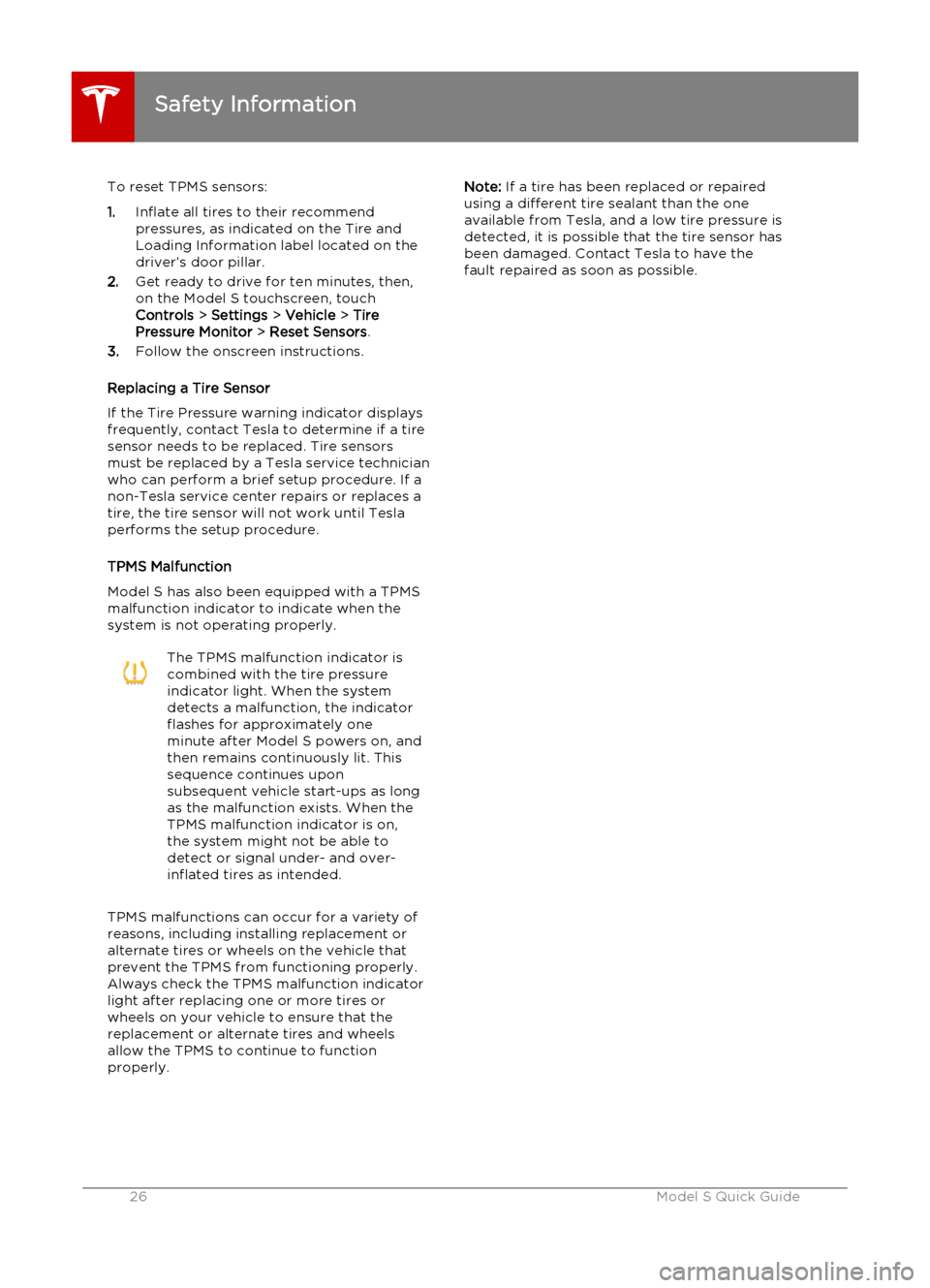service indicator TESLA MODEL S 2015 クイックガイド (in Japanese)
[x] Cancel search | Manufacturer: TESLA, Model Year: 2015, Model line: MODEL S, Model: TESLA MODEL S 2015Pages: 96, PDF Size: 2.86 MB
Page 5 of 96

Roadside Assistance......................2Contacting Roadside Assistance.......................... 2
Instructions for Transporters.................................. 3
Use a Flatbed Only 3Disable Self-Leveling (air suspension vehicles only) 3Activate Tow Mode 3Connect the Tow Chain 4Pull Onto the Trailer and Secure the Wheels 4
Safety Information..........................5Seat Belts....................................................................... 5
Wearing Seat Belts 5Wearing Seat Belts When Pregnant 6Seat Belt Pre-tensioners 6Testing Seat Belts 7Seat Belt Warnings 7
Child Safety Seats....................................................... 8
Guidelines for Seating Children 8Choosing a Child Safety Seat 9Seating Larger Children 11Installing Child Safety Seats 11Installing Seat Belt Retained Child Seats 11Installing ISOFIXChild Seats 12Attaching Upper Tether Straps 12Testing a Child Safety Seat 13Warnings - Child Safety Seats 13
Tesla Built-In Rear Facing Child Seats.............. 14
Usage Restrictions 14Opening 14Folding 15Seating a Child 16Warnings - Tesla Child Seats 17
Airbags.......................................................................... 18
Location of Airbags 18How the Airbags Work 19Types of Airbags 19Disabling the Passenger Front Airbags 20Inflation Effects 21Airbag Warning Indicator 21Airbag Warnings 21
Tire Care and Maintenance................................... 22
Maintaining Tire Pressures 22Inspecting and Maintaining Tires 23Replacing Tires and Wheels 24Using Tire Chains 25Tire Pressure Monitoring 25Understanding Tire Markings 27
Vehicle Loading.........................................................29
Load Capacity Labeling 29Calculating Load Limits 30Towing a Trailer 30Roof Racks 30
Disclaimers................................................................... 31
Vehicle Telematics/Data Recorders 31Quality Control 31
Declarations of Conformity.................................. 32
Key and Passive Unlocking System 32Tire Pressure Monitoring System 33Media Control Unit 33Radio Frequency Information 34
Reporting Concerns.................................................35
Contacting Tesla 35
Warranty..........................................36General Warranty Provisions............................... 36
Who is the Warrantor? 36What Vehicles are Covered? 36Multiple Warranty Conditions 36Limitations and Disclaimers 36Ownership Transfer 36Who Can Enforce this New Vehicle Limited Warranty? 37When Does the Warranty Period Begin and End? 37
Warranty Coverage................................................. 37
Basic Vehicle Limited Warranty 37Supplemental Restraint System Limited Warranty 37Battery and Drive Unit Limited Warranty 38
Exclusions and Limitations................................... 38
Warranty Limitations 38Additional Limitations and Exclusions 39Voided Warranty 40Damages 40
Obtaining Warranty Service................................ 40
Payment of Tax for Repairs 41Reasonable Time for Repairs 41Roadside Assistance (Japan) 41Modifications and Waivers 41
Dispute Resolution.................................................... 41Contents
Page 27 of 96

Inspecting and Maintaining TiresRegularly inspect the tread and side walls for
any sign of distortion (bulges), cuts or wear.Warning: Do not drive Model S if a tire is
damaged, excessively worn, or inflated to
an incorrect pressure. Check tires
regularly for wear, and ensure there are
no cuts, bulges or exposure of the ply/
cord structure.
Tire Wear
Model S is originally fitted with tires that have wear indicators molded into the tread pattern.
When the tread has been worn down to
1.6 mm, the indicators start to appear at the
surface of the tread pattern, producing the effect of a continuous band of rubber across
the width of the tire.
Replace a tire as soon as an indicator band
becomes visible or the tread depth reaches the minimum permitted by law.
Tire Rotation, Balance, and Wheel Alignment
Tesla recommends rotating the tires every 8000 km.
Unbalanced wheels (sometimes noticeable as vibration through the steering wheel) affect
vehicle handling and tire life. Even with
regular use, wheels can get out of balance.
Therefore, they should be balanced as
required.
If tire wear is uneven (on one side of the tire
only) or becomes abnormally excessive, check
the alignment of wheels.
Note: When replacing only two tires, always
install the new tires on the rear.
Punctured Tires
A puncture eventually causes the tire to lose
pressure, which is why it is important to check
tire pressures frequently. Permanently repair
or replace punctured or damaged tires as
soon as possible. Do not drive with a
punctured tire, even if the puncture has not
caused the tire to deflate. A punctured tire
can deflate suddenly at any time.
Your tubeless tires may not leak when
penetrated, provided the object remains in the
tire. If, however, you feel a sudden vibration or
ride disturbance while driving, or you suspect
a tire is damaged, immediately reduce your
speed. Drive slowly, while avoiding heavy
braking or sharp steering and, when safe to do
so, stop the vehicle. Arrange to have Model S
transported to a Tesla service center, or to a
nearby tire repair center.
Note: In some cases, you can temporarily
repair small tire punctures (under 6 mm) using
an optional tire repair kit available from Tesla. This allows you to slowly drive Model S to
Tesla or to a nearby tire repair facility.Warning: Do not drive Model S with a
punctured tire. Even if the punctured tire has not deflated, it can suddenly deflate
at any time.
Flat Spots
If Model S is stationary for a long period in
high temperatures, tires can form flat spots. When Model S is driven, these flat spots causea vibration which gradually disappears as thetires warm up and regain their original shape.
To minimize the flat spots during storage,
inflate tires to the maximum pressure
indicated on the tire wall. Then, before driving, release air to adjust tire pressure to the
recommended levels.
Driving in Low Ambient Temperatures
Tire performance is reduced in low ambient temperatures, resulting in reduced grip and an
increased susceptibility to damage from
impacts. Performance tires can temporarily
harden when cold, causing you to hear
rotational noise for the first few kms until the tires warm up. Contact Tesla for winter tire
recommendations.
Safety Information
Safety Information23
Page 29 of 96

Using Tire ChainsTesla has tested and approved Security Chain
Company (SCC) Model Z-563 chains for use
on the rear wheels. These chains must only be
used if your Model S has 245/45R19 rear tires
installed. Do not use chains on 21 inch tires.
When installing tire chains, follow the
instructions provided by the tire chain
manufacturer. Mount them as tightly as
possible.
When using tire chains:
• Drive slowly. Do not exceed 48 km/h.
• Avoid heavily loading Model S (heavy loads can reduce the clearance betweenthe tires and the body).
• Remove the tire chains as soon as conditions allow.
Note: Tire chains are prohibited in some
jurisdictions. Check local laws before installing
tire chains.Caution: Using non-recommended tire
chains, or using tire chains on other sized tires, can damage the suspension, body,wheels, and/or brake lines. Damagecaused by using non-recommended tire
chains is not covered by the warranty.Caution: Ensure that tire chains cannot
touch suspension components or brake
lines. If you hear the chains making
unusual noises that would indicate
contact with Model S, stop and
investigate immediately.
Tire Pressure Monitoring
Each tire should be checked monthly when
cold and inflated to the recommended
pressures that are printed on the Tire and
Loading Information label located on the
driver’s door pillar (see Maintaining Tire Pressures on page 22). If your vehicle has tires
of a different size than the size indicated on
the vehicle placard or tire inflation pressure
label, determine the proper tire inflation
pressure for those tires.
As an added safety feature, your vehicle has
been equipped with a tire pressure monitoring system (TPMS) that displays a tire pressuretelltale (Tire Pressure Warning) on the
instrument panel when one or more of your
tires is significantly under- or over-inflated.
Accordingly, when the Tire Pressure indicator
light displays on the instrument panel alerting
of tire pressure, stop and check your tires as
soon as possible, and inflate them to the proper pressure (see Maintaining TirePressures on page 22). Driving on a
significantly under-inflated tire causes the tire
to overheat and can lead to tire failure. Under-
inflation also reduces fuel efficiency and tire
tread life, and may affect the vehicle's
handling and stopping ability.If Model S detects a fault with the
Tire Pressure Monitoring System
(TPMS), this indicator flashes for one
minute whenever you power on
Model S.
Note: Installing accessories that are not
approved by Tesla can interfere with the TPMS system.
Warning: The TPMS is not a substitute for
proper tire maintenance, including
manually checking tire pressures and
regularly inspecting the condition of tires.
It is the driver's responsibility to maintain
correct tire pressure, even if under- or
over-inflation has not reached the level
for the TPMS to trigger the Tire Pressure Warning on the instrument panel.
Resetting the TPMS Sensors
After replacing one or more wheels, the TPMS sensors must be reset to ensure tire pressurewarnings are accurate. However, note that theTPMS sensors do not need to be reset after
replacing a tire or rotating wheels.
Note: When changing to 21" wheels
(Performance Plus models), the TPMS may
generate false tire pressure warnings. Bring
Model S to a Tesla Service center for further
adjustment.
Note: Do not reset the TPMS sensors in an
attempt to clear tire pressure warnings.
Safety Information
Safety Information25
Page 30 of 96

To reset TPMS sensors:
1. Inflate all tires to their recommend
pressures, as indicated on the Tire and
Loading Information label located on the
driver’s door pillar.
2. Get ready to drive for ten minutes, then,
on the Model S touchscreen, touch
Controls > Settings > Vehicle > Tire
Pressure Monitor > Reset Sensors .
3. Follow the onscreen instructions.
Replacing a Tire Sensor
If the Tire Pressure warning indicator displays
frequently, contact Tesla to determine if a tire
sensor needs to be replaced. Tire sensors
must be replaced by a Tesla service technician
who can perform a brief setup procedure. If a
non-Tesla service center repairs or replaces a
tire, the tire sensor will not work until Tesla
performs the setup procedure.
TPMS Malfunction
Model S has also been equipped with a TPMS
malfunction indicator to indicate when the
system is not operating properly.The TPMS malfunction indicator is
combined with the tire pressure
indicator light. When the system
detects a malfunction, the indicator
flashes for approximately one
minute after Model S powers on, and
then remains continuously lit. This
sequence continues upon
subsequent vehicle start-ups as long
as the malfunction exists. When the
TPMS malfunction indicator is on,
the system might not be able to
detect or signal under- and over-
inflated tires as intended.
TPMS malfunctions can occur for a variety of
reasons, including installing replacement oralternate tires or wheels on the vehicle thatprevent the TPMS from functioning properly.Always check the TPMS malfunction indicator
light after replacing one or more tires or
wheels on your vehicle to ensure that the replacement or alternate tires and wheels
allow the TPMS to continue to function
properly.
Note: If a tire has been replaced or repaired
using a different tire sealant than the one
available from Tesla, and a low tire pressure is
detected, it is possible that the tire sensor has
been damaged. Contact Tesla to have the
fault repaired as soon as possible.
Safety Information
26Model S Quick Guide